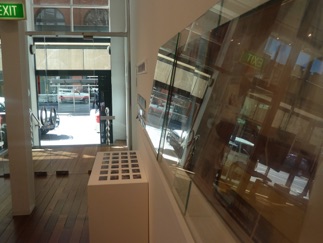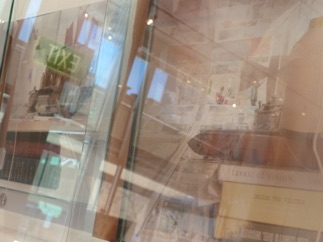Interior Archaeologies
An artwork, Things of Value was part of a wider exhibition that took place in the City Space Gallery, UK. The project started with a visual artist bringing together a collection of threads, objects, maps, elastic, a teapot and books, which were ordered and reordered and placed in relationship to each other. The objects became a landscape of provocation for others to make connections, to have conversations and express views they held.
The work established visual and physical relationships between the collection of objects and their contained meanings and memories. The objects contained personal memories of use, maps, ways of navigating space, and references to the loom as a set of actions involved in making, and to relevant physical locations. The artefacts and drawings acted as maps, as ‘snapshots of defining moments’ and became ‘tools’ in the developing discussion.1 A glass box became the frame for the collection, creating an interior landscape, a world within a world. Books, thread, pages, relationships were woven together as a fabric through a loom.
‘Things of Value’ acted as a site of exchange; it enabled an inter-disciplinary conversation between an artist, an archaeologist and an interior designer. Through discussions and drawing activities, they opened diverse approaches to looking and used different words and gestures to draw, interpret and re-interpret through the other and the said landscape. The aim was to ‘materialise discourse itself’.2 This process of materialising discourse, of the to and fro, backwards and forwards, zig-zagging between conversations, moving from one description to another, is, as Carter says, ‘like the shuttle ducking and weaving across the warp’ of a loom.2
The artwork acted as a laboratory, incubating ideas and discussions, making connections in the present, exploring past material, to model future thinking. The exchange moved between viewpoints forming knots and entanglements both within and between, forming ‘a meshwork of interwoven lines of growth and movement’,3 where knots have threads that ‘trail beyond, only to become caught with other threads in other knots’.3
Archaeology identifies different contexts of social activity by unearthing hidden space. Through the confusion and difficulty of interpreting what was an exposed landscape, the archaeologist was provoked to cover the glass cabinet in paper, returning to fundamental concepts in archaeology. The action transformed the perception of the material landscape for the artist and the interior designer, causing them to see through a curtain of paper onto a stage of activity. The apparent walls of the cabinet exposed views through the space of the interior to picture their entanglement in it.
The conversations formed an interior archaeology, where a spatial discourse around ideas of soil, finds, and fragments became woven into the conversation through the entanglements of interpretations. These conversations acted as open-ended set of activities of drawing and re-drawing, which Catherine de Zegher describes thus: ‘drawing is characterized by a line that is always unfolding and becoming’.4
1 Professor Jerry Brotton, Maps: Power, Plunder and Possession, London, BBC, 2010.
2 Clive Cazeau, ‘Inherently interdisciplinary: four perspectives on practice-based research’, Journal of Visual Arts Practice, vol. 7, 2010, pp. 107-132.
3 Tim Ingold, ‘Bringing things to life: creative entanglements in a world of materials”, <www.reallifemethods.ac.uk/.../vital-signs-ingold-bringing-things-to-life.pdf>, 2008.
4 Cornelia Butler and Catherine de Zegher, eds, On Line, Drawing Through the Twentieth Century, New York, The Museum of Modern Art, 2010.


